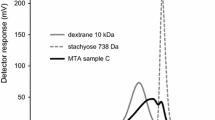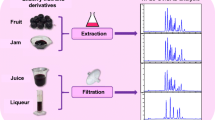Abstract
Limonin is well-known to induce the so-called “delayed” bitterness which is developing during standing and/or processing of orange juice. The objective of this study was to investigate the hydrolytic liberation of limonin from its precursor limonin-17-β-d-glucopyranoside in aqueous model solutions and orange juice samples. Quantitative model studies on the degradation of limonin-17-β-d-glucopyranoside under acidic conditions as well as during storage of orange juice revealed the formation of limonin besides a second hydrolysis product of yet unknown structure. After isolation, the structure of that compound was unequivocally determined for the first time as the C17-epimer of limonin, named C17-epilimonin. In order to investigate the generation of these triterpenoid lactones during storage as well as heat-treatment of orange juice, freshly squeezed orange juice was stored for up to 4 weeks at 4 and 20 °C or was heated at 70 and 100 °C and, then, both limonoids were quantitatively determined by means of high performance liquid chromatography-mass spectrometry/mass spectrometry (multiple reaction monitoring). The data obtained showed first evidence for the use of the C17-epilimonin/limonin ratio as a suitable marker for the analytical determination of the thermal input applied during processing orange juice products.








Similar content being viewed by others
References
Guadagni DG, Maier VP, Turnbaugh JG (1973) J Sci Food Agric 24:1277–1288
Fong CH, Hasegawa S, Coggins CW (1992) J Agric Food Chem 40:1178–1181
Maier VP, Beverly GD (1968) J Food Sci 33:488–492
Maier VP, Margileth DA (1969) Phytochemistry 8:243–248
Maier VP, Hasegawa S, Hera E (1969) Phytochemistry 8:405–407
Hasegawa S, Ou P, Fong CH, Herman Z (1991) J Agric Food Chem 39:262–265
Hasegawa S, Bennett RD, Herman RD (1989) Phytochemistry 28:1717–1720
Herman Z, Fong CH, Hasegawa S (1991) Phytochemistry 30:1487–1488
Stark T, Bareuther S, Hofmann T (2005) J Agric Food Chem 53:5407–5418
Manners G, Jacob RB, Breska AP, Schoch TK, Hasegawa S (2003) J Agric Food Chem 51:4156–4156
Author information
Authors and Affiliations
Corresponding author
Rights and permissions
About this article
Cite this article
Glabasnia, A., Hofmann, T. On the non-enzymatic liberation of limonin and C17-epilimonin from limonin-17-β-d-glucopyranoside in orange juice. Eur Food Res Technol 228, 55–63 (2008). https://doi.org/10.1007/s00217-008-0906-y
Received:
Revised:
Accepted:
Published:
Issue Date:
DOI: https://doi.org/10.1007/s00217-008-0906-y




